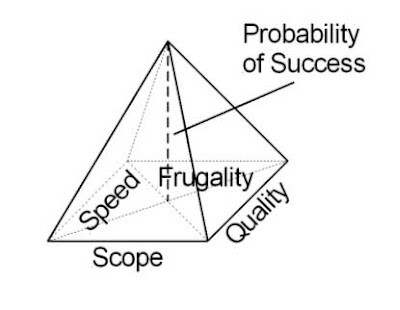
One of the most popular Chinese Strategy Classics is the 36 Stratagems. This essay focuses on six categories of strategies that are based on the positions of all competitors
When one's has the advantage of time and resources, the professional strategist does not rush into the situation. He builds a detailed plan and uses the approach of "Advantageous Strategems".
"Conserving energy while the enemy tires himself out" (以逸待劳 or "Yi Yi Dai Lao")
It is an advantage to choose the time and place for battle. In this way you know when and where the battle will take place, while your opposition does not. When the opposition has expend their energy in futile quests while you conserve your strength. When he is exhausted and confused, you attack with energy and purpose.
"Looting a house on fire" (趁火打劫 or "Chen Huo Da Jie")
When a company is beset by internal conflicts, they are not able to deal with an outside threat. This is the time for the superior company to attack.
###
Big tech goes bargain hunting
If you're a corporate giant with billions in cash, there's good news in the fear spreading around Silicon Valley. All those startups with technology you coveted? Fire sale!!!
By Michael V. Copeland, senior writer
October 28, 2008: 6:14 AM ET
(Fortune Magazine) -- These are the days that bring out the power shopper in Larry Ellison. With so much chaos in the markets and panic in the boardrooms, the Oracle CEO sees right now as a fine time to stroll through Silicon Valley and buy pretty much whatever he wants.
"We are better positioned than our peers to do well in tough times," Ellison declared at Oracle's annual meeting in October. "Acquisitions we have been looking at for some time are more attractive."
He's not talking about buying anything with stock. Like every tech company's shares, ORCL has been clobbered - it's down 22% since January, compared with -36% for the Nasdaq. No, he's talking about cash. Oracle (ORCL, Fortune 500) has $13 billion - and Ellison is ready to spend. Some of that money will be deployed to repurchase Oracle shares. (The company's board recently approved a stock buyback of up to $9.3 billion.) But Ellison said at the annual meeting that he planned on keeping up his 12-company-a-year buying habit.
What's he feeding on? A diet of "small companies that are fast-growing," though he doesn't rule out big purchases. Two days before his speech, as markets were melting, Ellison put down an estimated $300 million to buy Primavera Software, a privately held project-management technology company.
Ellison, of course, isn't the only tech potentate sitting on a pile of cash. Cisco (CSCO, Fortune 500)'s John Chambers, HP (HPQ, Fortune 500)'s Mark Hurd, Microsoft (MSFT, Fortune 500)'s Steve Ballmer, and Google (GOOG, Fortune 500)'s Eric Schmidt, among others, all have billions at their disposal. Even the normally purchase-resistant Steve Jobs sounded a bit acquisitive during Apple's recent earnings conference call. (Other big tech names may not join in the shopping spree - Sun Microsystems (JAVA, Fortune 500) and Yahoo come to mind, both of which have had serious sales declines. IBM is still growing revenues and has cash, but it's also carrying $34.4 billion in debt.)
So who's going to get bought? For now, the quarry seems to be small private outfits with technology the big guys covet. Recent examples: HP's purchase of storage startup Lefthand Networks for $360 million; Intel's acquisition of networking-gear maker NetEffect for $8 million.
"The deal flow is as busy as I've seen it," says Michael Barker, managing director with Revolution Partners, a boutique investment bank. "Sure, you have some VCs who think their zero-revenue social-networking company is still worth $500 million, but mostly they understand that prices are coming down. If you are a buyer, you have carte blanche."
If you are a seller, you are over a barrel. VCs are loath to sell their best companies now, because they know it's a buyer's market. "In this environment it turns into a fire sale," says Jason Green, a VC with Emergence Capital, based in San Mateo, Calif. But those sales are happening anyway, as VCs comb through portfolios deciding which companies to hang on to and which to let go.
Two types of companies are destined for the sales bin. Type one: startups without revenue that will soon need another round of financing just to get by. Any number of the dozens of Internet video startups that launched in the past two years fall into that category.
Type two: later-stage companies with big burn rates that have been hoping to go public. Just scan the tech companies withdrawing IPOs, such as content-delivery company Synacor and software maker Varolii, for example. With both types of companies, the money they and their VCs were banking on has been squeezed off, so selling for cheap might be the only option.
Even facing that pain, there is no lack of sellers, says Ned Hooper, Cisco's head dealmaker. Hooper led Cisco's purchases of WebEx (online conferencing service) and IronPort (security software). And Cisco, which has a Valley-leading $26.2 billion in cash, is in the market for more.
Before 10 o'clock one recent morning, Hooper already had three eager bankers dial him up. He says recent calls tend to start the same way: "Hey, Ned it's been a while. I've got a great idea I want to run by you." Then they talk about Cisco buying their company. "If it's not nailed down, it's for sale," Hooper says. "It hasn't been like this since 2001."
Cisco has always been a buyer, in good times and bad, but it likes picking up companies during downturns, after they've had to learn some financial discipline. Hooper says that any purchase Cisco makes will have to be strategic (translation: add revenue). That, more than price, will determine Cisco's level of interest. "If you are three months from raising a round of financing and it's clear that is why you are selling, don't come to us," Hooper says. "We are not the buyer of last resort."
What's clear is that after several years of paying up for tech companies - of being forced into bidding wars with massive private equity shops and hedge funds dabbling in venture capital - the Valley's big tech leaders are glad to be back in demand and in control of the deals.
Case in point: Dan Warmenhoven, CEO of data-storage company Network Appliance. Over lunch in San Francisco recently, Warmenhoven clearly enjoys his fish and chips about as much as he relishes his new position of strength. NetApp may not have the massive coffers of Cisco, but Warmenhoven has $2.1 billion in cash at the ready.
He says he wouldn't mind picking up "something that adds to our toolkit." Like what? "Technology that would have cost me $100 million a year ago but might go for $11 million today. Deals like that." He checks a burst of incoming messages on his BlackBerry and says with a grin, "Look, the offers are coming in right now."
http://money.cnn.com/2008/10/
--











